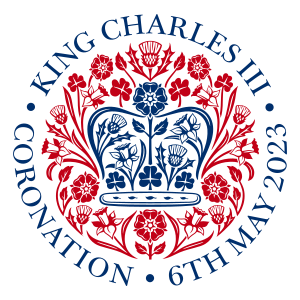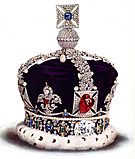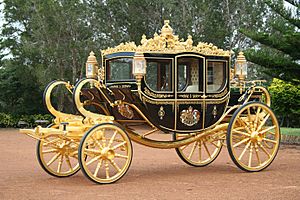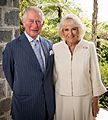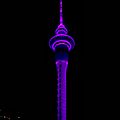Coronation of Charles III and Camilla facts for kids
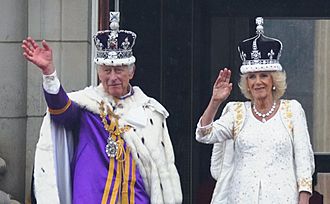
Charles and Camilla on the front balcony of Buckingham Palace
|
|
| Date | 6 May 2023 |
|---|---|
| Venue | Westminster Abbey |
| Location | London, United Kingdom |
| Participants |
|
The coronation of Charles III and his wife, Camilla, as King and Queen of the United Kingdom happened on 6 May 2023. It took place at Westminster Abbey in London. Charles became King on 8 September 2022, after his mother, Queen Elizabeth II, passed away.
This special religious ceremony is full of meaning. It included Charles being anointed with holy oil, getting the royal items (called regalia), and being crowned. This showed his important spiritual role and his duties as a ruler. Leaders from the Church of England and the royal family promised their loyalty to him. People across the Commonwealth realms were also invited to show their support.
Charles and Camilla's coronation was the first for a British monarch in the 21st century. It was also the 40th coronation to be held at Westminster Abbey. The first one there was for William the Conqueror on 25 December 1066.
Contents
Getting Ready for the Big Day
Charles III became King right after his mother, Queen Elizabeth II, died on 8 September 2022. He was officially announced as King by the Accession Council on 10 September. Other Commonwealth realms also made similar announcements. Even during Queen Elizabeth's reign, plans for Charles's coronation were being made. These meetings, called "Operation Golden Orb," happened at least once a year. People from the government, the Church of England, and Charles's team attended them.
The date for the coronation, 6 May 2023, was announced on 11 October 2022. This date allowed enough time for people to mourn Queen Elizabeth II before celebrating the new King.
The coronation is a big national event, paid for by the British government. Because of safety rules, only about 2,000 guests could attend the ceremony at Westminster Abbey. A special office was set up to handle requests from people who had a historic role to play in the coronation. A very old military role, the Lord High Constable of England, was given to Admiral Sir Tony Radakin for the coronation.
The special holy anointing oil used in the service was blessed in Jerusalem on 6 March 2023. It was made using the same recipe as the oil for Queen Elizabeth II's coronation, but without any animal products.
Royal Clothes and Crowns
Breaking from some past traditions, King Charles chose to reuse many of the royal clothes, called vestments, from earlier coronations. The supertunica and robe royal are usually reused. However, Charles also wore other vestments that belonged to Kings George IV, George V, George VI, and Queen Elizabeth II.
Queen Camilla also reused some royal clothes, including Queen Elizabeth II's robe of state. But she also wore a new robe of estate. This new robe had her royal symbol, bees, a beetle, and different plants and flowers on it. These included lily of the valley, myrtle, delphinium, lady's mantle, maidenhair fern, and cornflowers.
St Edward's Crown, which was used to crown the King, was taken from the Tower of London in December 2022 to be made the right size. In February 2023, Queen Mary's Crown, used for Queen Camilla, was also taken out for changes. This crown was fitted with special diamonds and some of its arches were removed. This was the first time a queen was crowned using another queen's crown since 1727.
The Coronation Day
The coronation day included several exciting parts. First, there was a procession from Buckingham Palace to Westminster Abbey. Then came the coronation service itself. After that, another procession went back to Buckingham Palace. Finally, the King and Queen appeared on the palace balcony for a special flypast by the Royal Air Force.
The procession into the abbey was led by leaders from many different faiths. These included Bahai, Buddhist, Hindu, Jain, Jewish, Muslim, Sikh, and Zoroastrian communities. Christian leaders from different churches followed them. After this, flags from the Commonwealth realms were carried by representatives. The choir then entered the abbey.
The King and Queen arrived just before 11:00 AM and had their own procession. Four important people led it, carrying special flags with the royal coat of arms. Charles and Camilla each had four young helpers, called pages of honour. These included Prince George of Wales and Camilla's grandsons. Camilla also had two ladies with her, her sister and the Marchioness of Lansdowne. The choir sang a song, and students from Westminster School cheered, "Long live Queen Camilla!" and "Long live King Charles!"
The coronation service had several distinct parts. It was based on an Anglican Holy Communion service. First, Charles and Camilla walked into the abbey. Then, Charles was presented to the people and recognized as the monarch. After this, Charles took an oath. He promised to rule each of his countries fairly, to administer justice with mercy, and to protect the Church of England. He then went to the altar and said, "The things which I have here before promised I will perform and keep. So help me God."
Next, he was anointed with holy oil. He was then given the coronation regalia and crowned with St Edward's Crown. After this, he sat on his throne and received promises of loyalty from important people and the public. Camilla was then anointed and crowned. She was given her own royal items, the Queen Consort's Sceptre with Cross and the Queen Consort's Rod with Dove. She then sat on her own throne next to the King. This was the first time a Queen Consort had been crowned since Queen Elizabeth in 1937.
At the end of the service, the King changed into the Imperial State Crown. Charles and Camilla then walked out of the abbey as the national anthem, "God Save the King", was sung. As they left, the King was greeted by leaders from Jewish, Hindu, Sikh, Muslim, and Buddhist communities.
The second procession followed the same path as the first, but in reverse. It was also much grander. The King and Queen rode in the Gold State Coach, pulled by eight horses. Other members of the royal family rode in other vehicles.
The armed forces from the UK and the Commonwealth played a very important part. Over 5,000 members of the British Armed Forces and 400 personnel from at least 35 other Commonwealth countries were part of the two processions. Another 1,000 lined the route. At Buckingham Palace, the King and Queen received a royal salute from the armed forces. Then, they joined other working members of the royal family on the balcony to watch a six-minute flypast of more than 60 aircraft.
Guests and Celebrations
About 2,200 guests from 203 countries were invited to the coronation. These included members of the royal family, church leaders, important politicians from the UK and the Commonwealth, and foreign heads of state and royalty.
Many public events and street parties were planned across the UK and the Commonwealth. Over 3,300 public events and 526 private street parties were registered. British embassies and churches around the world also marked the event. A public holiday was declared in the UK on 8 May to celebrate the coronation.
The UK government also gave out special coronation medals to 400,000 people. These included those who helped with the coronation, emergency workers, and members of the British Armed Forces. The medals are made of nickel silver and have a picture of the King and Queen on them.
The Royal Mint released new coins, including 50p and £5 coins, showing the King wearing the Tudor Crown. Royal Mail issued four new stamps to mark the coronation, just like they did for past coronations.
Even the voice announcements on Transport for London trains and stations were changed. The King and Queen recorded new announcements that were used during the coronation weekend. A train from London to Edinburgh was even named the Carolean Express for the occasion.
Natural England will create new National Nature Reserves in honor of the coronation. Five major reserves will be named each year for the next five years.
Special coronation souvenirs were released by the Royal Collection Trust. Other companies also made their own coronation items, like pottery and toys. Some companies even created special beers to mark the event.
Watching the Coronation
The BBC made it free for venues to show the coronation and the concert without needing a TV license. The government also set up big screens in 57 locations across the UK, including in Hyde Park.
Media channels in the UK, Australia, Canada, France, Germany, New Zealand, and the United States broadcast the coronation live. Many broadcasters provided coverage throughout the coronation weekend.
The Stone of Scone's Journey
The Stone of Scone is a very old and important stone used in coronations. In October 2022, some people signed an online petition asking for the Stone of Scone to stay in Edinburgh Castle for the coronation. Despite these requests, the Stone of Scone was moved to London on 28 April 2023 for the coronation. The First Minister of Scotland was there when it left Edinburgh Castle.
See also
 In Spanish: Coronación de Carlos III del Reino Unido y Camila para niños
In Spanish: Coronación de Carlos III del Reino Unido y Camila para niños
Images for kids
-
A postbox topper to mark the coronation in Goddington, south London
-
The Stone of Scone is carried out from Edinburgh Castle in preparation for its use in the Coronation
-
A Union Jack defaced with the coronation emblem in the High Street at Bexley, London
-
The Stone of Scone is carried out from Edinburgh Castle in preparation for its use in the Coronation
-
The King and Queen returning from Westminster Abbey to Buckingham Palace in the Gold State Coach
-
Staff from the British Embassy in Washington D.C. volunteer at the Capital Area Food Bank on 8 May as a part of the Big Help Out initiative
-
The ballroom of Government House, Perth during an open house to mark the coronation. A group poses next to a photo portrait of Charles and Camilla in the background.
-
The interior arch of Princes' Gates illuminated in emerald green to mark the coronation
-
A coronation fair hosted by the government of Ontario at Queen's Park in Toronto


